Planning the next steps in your landscape design should be a time full of inspiration and excitement, but it’s often a time of overwhelm. The creative process in landscape design may be marred by lack of ideas, budget, and simply too many ideas that make it hard to nail down a final design. Not sure how to bring your vision to life? Here is how a landscape designer in the Wyomissing, PA area can help.
Related: How a Landscape Contractor Can Bring Your Patio Ideas to Life in Exeter, PA
Getting on the Same Page
A landscape designer’s first job is to fully understand the vision of the homeowner. Through various conversations and drawings, a landscape designer can execute and even improve upon this vision. Great landscape designers will ensure that their clients feel fully heard and understood throughout the process.
Deciding on a Theme
Landscape design is as complex as home design. One of the first steps is deciding on a theme - or in essence, the feeling of the space: formal, casual, romantic, rustic, etc.. This theme should be inspired by and complementary to the home itself and the natural landscape. A landscape designer will help you decide on a theme that will guide materials choices and the design itself.
Defining Central Spaces
The central spaces of your outdoor living space are where you and your family spend the most time enjoying your favorite activities (entertaining, swimming, relaxing, playing, etc.). Whatever your family’s favorite outdoor activities are, these will make up the core of your outdoor living space. A landscape designer will help you create a zoned approach that ensures high-activity zones are conveniently located and out of the way of lower-activity zones.
Creating Tasteful Transitions
The areas between your landscape’s central spaces are key areas to making the space feel cohesive. Transitions in landscape design include masonry paved surfaces, curated plantings, changes in lighting strategies, and changes in elevation.
Layering Visuals
A successful landscape design will prioritize how the features are perceived from different perspectives. Layering is a technique applied in many areas of a landscape design in order to create a dynamic and complex space that feels completely intentional. In all aspects of plant design and arrangement of various features, it’s important to layer visuals. In some landscapes, you’ll see tall and dense elements such as trees and shrubs pushed against the perimeter, with shorter and lighter elements in front. However, this creates the illusion of less space. And, it’s boring. A landscape designer will create dynamic layers throughout the landscape - not just at the perimeter - to give your landscape incredible depth and interest anywhere you look.
Highlighting Focal Points
Focal points are designed to draw attention, helping create a sense of immersion. Common focal points include trees, prominent plantings, water features, seating areas, and fire features. A landscape designer will create several focal points to make your landscape a joy to look at.
Spending Time on Details
A great landscape design won’t feel bland or like it was created solely on the drawing table. The key to a successful landscape is all the little details that were deliberately placed with a careful eye of a design professional.
Implementing Creative Solutions
Most landscapes aren’t a perfect canvas waiting to be designed. There could be challenges such as slopes, uneven ground, ugly views, and poor drainage. A landscape designer will draw on their creativity as well as practical knowledge to overcome challenges and, in fact, turn them to your advantage.
Related: Here's How a Landscape Designer Can Create the Perfect Fire Pit in Blandon, PA


